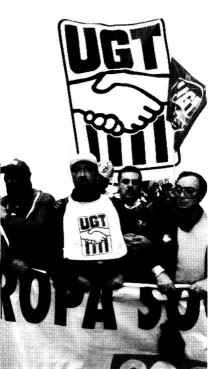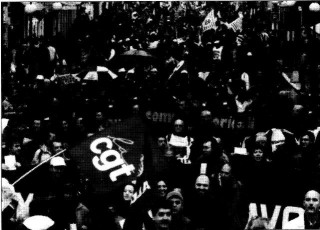
From Socialist Review, No.248, January 2001.
Copyright © Socialist Review.
Copied with thanks from the Socialist Review Archive at http://www.lpi.org.uk.
Marked up by Einde O’Callaghan for the Marxists’ Internet Archive.
|
We can’t build the movement of today using the methods and politics of the past two decades argues Chris Harman |
|
|
‘The past hangs like a nightmare on the brain of the living.’ So wrote Marx, analysing the events of that great year of revolution, 1848. The phrase came back to me at the beginning of last month when I attended a big conference called by various organisations of left wing French intellectuals to mark the first anniversary of Seattle. The fact that they had called the conference was testimony to the impact of Seattle worldwide in signalling the emergence of a new minority opposed to the global system.
The spirit of Seattle expressed itself in the scale of attendance, with some 2,000 registering for the conference. But the central element in the spirit of Seattle was often completely missing from what the speakers had to say. This was the sense of a new, fighting movement which brought together in opposition to a single enemy the disparate, fragmented, one-issue movements of the 1980s and 1990s. In part this was because of the continuing influence of the French Communist Party among some of the key organisers of the conference. Talk of a ‘plural left’ is its excuse for participating in a government which is implementing neoliberal policies. The conference was a chance for it to try to protect itself from criticism on its left by ‘recouping’ or grabbing for itself the impact of Seattle.
This meant a conference against capitalist globalisation included among its plenary speakers mainstream Socialist Party ministers and even a former Socialist Party prime minister from the Mitterrand era.
Their presence symbolised an overall tendency to try to impose the pessimism and fragmentation that characterised the old left of the 1980s and 1990s on the emerging new left of the new millennium. Those were decades of defeat. In some countries, like Chile after the coup of 1973 and Argentina after the coup of 1976, these were devastating and bloody defeats. In other countries, like Italy after the victimisations at Fiat in Turin in 1976 and 1980, and in Britain in 1984-85, lesser but still enormous defeats. A whole generation of activists lost faith in their ability to challenge the system. Many still wanted to resist individual oppressions, injustices and horrors. But the movements that arose over such issues were isolated from each other and ended up pushing for individual demands within the system – a trend which culminated in the identity politics and its intellectual correlate, the postmodernism which denied the very reality of a total system or the possibility of a unified struggle. All these trends were reinforced with the internal collapse of the old Eastern Bloc. A huge chunk of the left confused the demise of their own illusions with the end of any viable alternative to capitalism.
A new wave of struggle began to emerge in the second half of the 1990s, most vividly with the Zapatista rising in Chiapas in Mexico in 1994, and the strikes in France in November and December 1995. These roused new hope in many people. But they did not by themselves break the pessimism and sectionalism of much of the left. On occasions the new movements made big concessions to it. So both the Zapatistas and the guerilla movements in Colombia speak in terms of negotiating with their governments for ‘autonomy’, not building nationwide revolutionary movements to overthrow them.
The importance of Seattle was precisely that it challenged the sectionalism and pessimism. It raised once again the vision of the late 1960s and early 1970s, of a unified worldwide movement against all the oppressions, and connected with the struggle against the exploitation of the world’s workers. But, as the Paris conference showed, that does not automatically mean that all the conceptions simply melt away. Indeed, promoting such conceptions suits political forces like the French Communist Party who want to drag the new anti-system activists into their own parliamentary games. Emphasis on the ‘autonomy’ of different struggles encourages a sectionalism that means no one has the force to confront the main centres of capitalist power. That can leave the new activists feeling that lobbying friendly ministers is the only option open to them.
Fortunately, that is by no means the end of the matter. The spirit of confrontation and unity against a single system will not go away simply because this suits parties which hold governmental posts. It is something affirmed by people in the movement still a long way from revolutionary Marxism, like Susan George and Naomi Klein, when they criticise the old identity politics. It was something to be found in the Nader presidential campaign in the US. It will be found in every new movement against particular forms of oppression that arise post-Seattle. But the new will not emerge triumphant without a fight against the old. The message of Seattle was that we face a united system and need to see ourselves in a united battle against it. That is the message we have to oppose to the politics of the 1980s and 1990s.
The importance of this fight was shown four days after the Paris conference at the demonstrations outside the European Union intergovernmental meeting in Nice on 6 and 7 December. The first demonstration, on 6 December, had been called by the main European trade union federations. The union leaders had intended it to be a token show of force aimed at pressurising the intergovernmental meeting into passing a very tame European Charter of Fundamental Rights.
The demonstration was nevertheless huge, vibrant and combative, drawing workers together from across national frontiers, and from across the bureaucratic divides that plague the trade union movement in countries like France, Spain and Italy. Running right through it was the spirit of unity in struggle created in France in the strikes of November and December 1995, with the slogan ‘Tous ensemblerlsquo; – All together. And the union leaders’ ‘charter’ hardly got a look in as everywhere the chants and placards called for a ‘social Europe’ in contrast to ‘the Europe of capital’. It should have been the ideal opportunity for the anti-capitalist left in France to make the connections with tens of thousands of trade union activists who have to battle against the effects of neoliberalism every day in factories, offices, docks, hospitals and schools. Unfortunately, however, the bulk of the left had decided to abstain from that demonstration and miss the chance to articulate the anti-capitalist feelings of most of its participants. They announced in advance they were organising a separate demonstration of their own.
 |
|
Part of the Nice demonstration |
The claim was that this approach would bring together the ‘radical’ unions (the Sud breakaway from the CFDT in France, the Cobas in Italy, the anarcho-syndicalist CNT in Spain), the ‘social movements’ of the unemployed, the homeless and the sans papiers immigrants in France, and the anti-neoliberal movement Attac, in a protest many thousands strong. It would also allow those taking part in this second demonstration to stay overnight to carry out a Seattle-type blockade of the intergovernmental meeting the following day. In fact, however, it meant a continuation of the old trend for much of the far left in southern Europe to allow themselves to be isolated in ghettos cut off from the mass of workers organised in the big unions. One expression of this trend is the tendency to form separate, far left led unions every time the bureaucrats who organise the mass of workers try to prevent dissent in the unions they run. The other is a certain tendency for those involved in particular movements against oppression to attack the whole trade union movement as the enemy.
In the event ‘the many thousands’ were perhaps up to 5,000. On the Wednesday they ended up not forming a separate demonstration but simply a final, somewhat bedraggled contingent cut off from the excitement of the massive main trade union demonstration. And the Italian anti-capitalist organisation Ya Basta! did not aim to arrive in Nice until the main trade union demonstration was over. This enabled the French police to stop it crossing the border, in a way which would have been impossible earlier in the day when tens of thousands of Italian trade unionists were doing so.
On the Thursday the smallness of the numbers was such that Attac decided to abandon even a token blockade of the intergovernmental meeting (but still got teargassed!), and the Trotskyist Ligue Communiste Rvolutionaire would have done the same if it were not for pressure from some of its younger members.
The people who emerged with some credit on that day were not the French far left, with its apparently large electoral support and its splinter trade unions, but those people who had travelled from across Europe and insisted on making enthusiastic attempts to protest on the Thursday despite successive police attacks.
What became clear as we coughed our way through the teargas was that the organisations of the French left had followed a policy that was simultaneously reformist and sectarian. While counterposing to the official leaders of the main trade union federations a slightly more radical version of reforming demands, they had cut themselves off from the mass of union activists across Europe in order to do so. And they had failed utterly to capture the mood of the anti-capitalist minority. This minority is bigger, both among young people and trade unionists, in France than virtually anywhere else as a result of the successful strikes in November and December 1995.
But the supposedly big far left organisations in France failed to connect with it in the run-up to Nice. They too are held back from doing so by the ideas which came to dominate in the 1980s and 1990s. The electorally quite successful organisation Lutte Ouvrière criticised Seattle and refused to mobilise for Nice. The LCR never turned its words about building for Nice into deeds. Attac did not build Nice either despite hectic efforts by key figures like Susan George. Many of its leaders want it to be a respectable lobbying organisation rather than one which mobilises its 20,000 supporters to fight the system.
The missed opportunities around Nice are important for the whole of Europe. France has the highest level of working class combativity on the continent. But the employing class will not put up with this indefinitely. At some point it will launch a counter-offensive designed to shift the balance of class forces to its own benefit, much as the Thatcherites did in Britain in the 1980s. And, like them, it will rely on being able to take advantage of the cowardice and treachery of the union bureaucracies. It may well also look to the weakened but still extant forces of the French far right to divide workers one against another. In such a situation the existence of an anti-capitalist current in every workplace and every locality prepared to resist such manoeuvres can make the difference between victory and defeat. The potential to build such a current exists. But the Paris conference and Nice both show how easy it is to miss the chance to do so.
Last updated on 1 January 2010